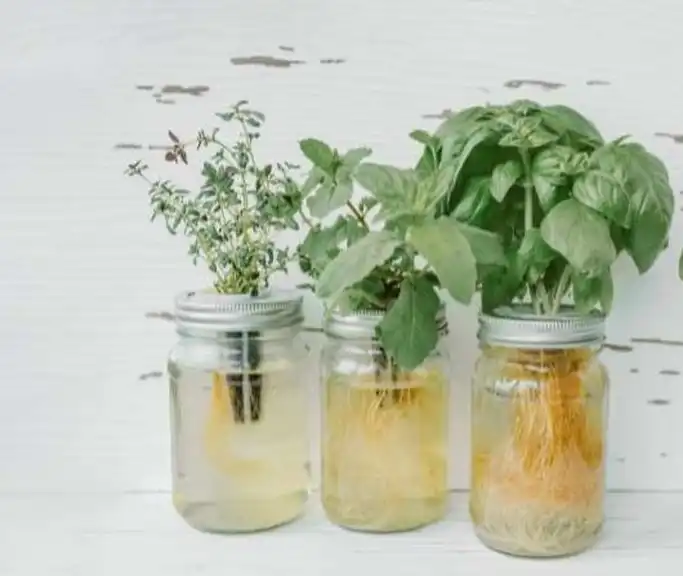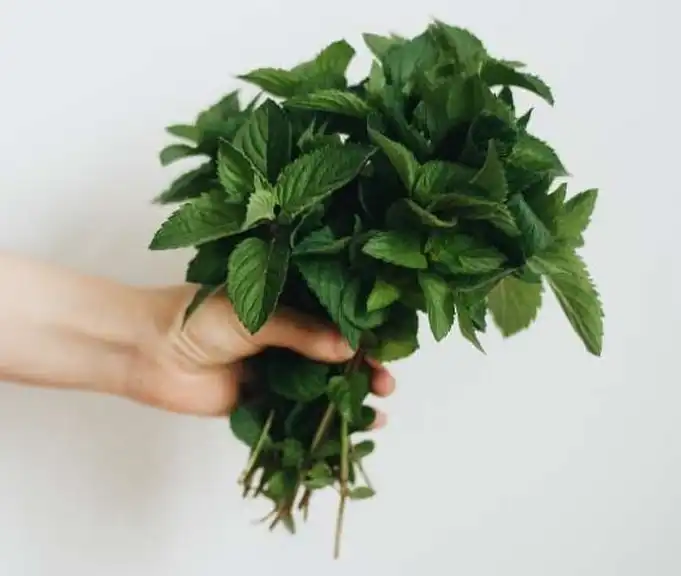Indoor gardening offers a world of possibilities. It brightens your living space and provides an accessible way to grow your favorite herbs, fruits, and vegetables. This exploration will dive into the multifaceted benefits of growing mint indoors, enriching your life one leaf at a time.
7 Remarkable Benefits of Growing Mint Indoors

They are Remarkable Benefits of Growing Mint Indoors:
A Fresh, Fragrant Home Environment
Indoor plants do more than beautify a space; they can also significantly influence the ambiance of your home. With its uniquely refreshing and invigorating scent, mint is a natural air freshener, creating a fresh, fragrant environment that elevates your indoor living space.
- Natural Air Freshener: Mint’s robust aroma has a freshness that can help to neutralize unpleasant odors in your home. Unlike commercial air fresheners, which often contain artificial fragrances and chemicals, mint offers a natural, non-toxic alternative.
- Mood Enhancement: Scents have a profound effect on our mood and emotions. The smell of mint is known to have an uplifting and revitalizing effect. It can help to relieve stress, increase alertness, and enhance overall mood.
- Improved Sleep: Mint’s aroma also has calming properties, which can contribute to better sleep. Placing a mint plant in your bedroom could help create a serene, relaxing environment conducive to a good night’s sleep.
- Aesthetic Appeal: Mint plants, with their vibrant green leaves, contribute to the aesthetic appeal of your home. The visually pleasing sight of a flourishing mint plant, coupled with its delightful scent, can enhance the ambiance of any room.
- Insect Repellent: The strong scent of mint is a natural deterrent for many insects, including mosquitoes and flies. Therefore, having mint plants indoors can help to maintain an insect-free environment.
By cultivating mint indoors, you are not just adding another plant to your home; you are infusing your living space with a fresh, pleasant aroma that can elevate your mood, improve your sleep, and deter unwanted insects. It is an easy and natural way to create a more enjoyable and comfortable home environment.
An Evergreen Source of Culinary Delight
Mint is a perennial herb, making it an evergreen culinary delight that can be harvested all year round. Its vibrant taste and refreshing aroma make it a versatile addition to numerous dishes and beverages. The ability to pluck fresh mint leaves right from your indoor garden adds a newfound level of vibrancy to your culinary exploits.
- Innovative Beverages: Mint is best known for its use in beverages, contributing to its refreshing, cool flavor. From the classic mojito to refreshing mint tea or cooling mint lemonade, having a ready supply of fresh mint leaves allows you to experiment and create a range of thirst-quenching drinks. Its aromatic qualities also enhance the overall sensory experience of enjoying a beverage.
- Flavorful Foods: The unique taste of mint is a wonderful addition to various dishes. Mint can be used in salads, with fruits, blended into sauces, or even as an unexpected flavor burst in cooked dishes. Traditional recipes like tabbouleh, tzatziki, and chutneys benefit from mint’s fresh, uplifting flavor.
- Desserts and Sweets: Mint is not just for savory dishes and drinks but also a delightful addition to sweets and desserts. Mint-infused chocolates, cakes, ice creams, and cookies are all tantalizing ways to enjoy this versatile herb.
- Preservation and Use in Non-Culinary Ways: Mint leaves can be dried or frozen for preservation, ensuring you have a stock of this versatile herb ready for off-season use. Additionally, mint’s refreshing scent makes it a popular addition to homemade soaps, candles, and other DIY projects.
- Healthful Additions: Mint’s therapeutic advantages enhance the nutritional profile of the dishes it is incorporated into. From aiding digestion to relieving headaches, the benefits of mint add a healthful boost to your culinary creations.
Growing mint indoors means you have an evergreen source of this culinary delight at your fingertips. Its ability to elevate a simple dish or beverage with its distinctive flavor and aroma enhances the taste of your food and the joy of cooking and eating. The accessibility of fresh mint can inspire creativity in the kitchen, encouraging you to explore new recipes and experience the versatile charm of this aromatic herb.
The Therapeutic Advantages of Mint
Mint, scientifically known as Methane, is more than a flavorful herb; it is a powerhouse of therapeutic benefits. It has been utilized for thousands of years for its healing properties. Here are some notable therapeutic advantages of mint that make growing it indoors rewarding.
- Digestive Health: Mint has long been recognized for its ability to soothe digestive troubles. It helps promote digestion, relieve indigestion, and reduce symptoms associated with irritable bowel syndrome. This is attributed to its naturally occurring compound, menthol, which has antispasmodic properties that relax the gastrointestinal tract muscles (Grigoleit & Grigoleit, 2005).
- Respiratory Relief: The strong aroma of mint effectively clears up congestion of the nose, throat, and lungs, offering relief during a cold or flu. The menthol in mint also acts as a natural decongestant, relieving coughs and chest tightness (Eccles, 2003).
- Headache Relief: Mint can aid in alleviating headaches and migraines. The cooling effect of menthol can help relax muscles and ease pain, making mint oil a popular home remedy for headaches (Göbel, Heinze, Heinze-Kuhn, Göbel, & Göbel, 2016).
- Mental Clarity and Fatigue Reduction: The scent of mint can increase alertness and memory capacity. A study published in the International Journal of Neuroscience found that inhaling the aroma of mint essential oil can enhance memory and increase alertness (Moss, Cook, Wesnes, & Duckett, 2003).
- Dental Health: Mint has antimicrobial properties that can inhibit the growth of bacteria in the mouth, contributing to better oral health. This is why mint is a common ingredient in toothpaste, mouthwash, and other dental hygiene products (Albuquerque et al., 2006).
- Skin Health: Mint has anti-inflammatory and anti-bacterial properties that can help treat skin issues. It can soothe irritated skin, reduce redness, and manage acne symptoms. Mint also contains salicylic acid, which can help treat and prevent pimples (Mittal, Gupta, Parashar, Mehra, & Khatri, 2014).
Cultivating mint indoors provides easy access to a natural remedy with many health benefits. Adding mint to your daily routine, whether in a refreshing tea or a homemade skin-care product, can help enhance your well-being naturally.
Economical and Sustainable Living
Indoor gardening, particularly growing mint, embodies economic prudence and sustainable living. The amalgamation of these concepts renders growing mint indoors a practice that extends beyond simple horticultural pleasure, also serving as a way to live more sustainably while cutting costs.
- Minimize Grocery Expenses: Mint is a versatile herb used in many recipes, from teas and cocktails to sauces and salads. Instead of regularly purchasing mint from the grocery store, growing your own can significantly reduce food expenses over time. An indoor mint plant can provide a continuous supply of fresh leaves, readily available whenever needed.
- Reduce Food Waste: When you purchase mint from the store, it can wilt or become moldy if not used promptly, leading to waste. With a living mint plant in your home, you can harvest what you need when you need it, reducing food waste.
- Eliminate Packaging: Store-bought mint often comes in plastic packaging, contributing to environmental pollution. Growing your mint eliminates the need for such packaging, reducing your plastic footprint.
- Cut Down on Food Miles: Food miles refer to the distance food travels from where it is grown to where it is consumed. These miles contribute to greenhouse gas emissions and climate change. Growing mint at home eliminates these food miles, making your mint consumption more environmentally friendly.
- Promote Self-Sufficiency: Growing your mint fosters a sense of self-reliance and resilience. This is particularly beneficial in supply chain disruptions, as you have a fresh supply of mint at your fingertips.
- Encourage Organic Practices: Growing your mint allows you complete control over plant cultivation. You can grow your mint organically, avoiding harmful pesticides and chemical fertilizers.
By integrating indoor mint cultivation into your lifestyle, you embrace an economical approach and participate in sustainable living practices. Growing mint is a small but significant step towards a more sustainable future, paving the way for mindful consumption and stewardship of our planet.
Indoor Air Quality Improvement
Indoor air quality is a vital aspect of our health and well-being that is often overlooked. In a world where we spend an increasing amount of time indoors, whether in our homes or workplaces, the air quality we breathe has never been more important. Fortunately, indoor plants, such as mint, can serve as natural air purifiers, improving indoor air quality in multiple ways.
- Carbon Dioxide Reduction: Plants absorb carbon dioxide and release oxygen during photosynthesis. This exchange not only replenishes the oxygen in our homes but also helps reduce the levels of carbon dioxide, enhancing the overall quality of indoor air.
- Volatile Organic Compounds (VOCs) Absorption: Plants can remove toxic gases, such as benzene, formaldehyde, and trichloroethylene, from the air. These gases are commonly emitted from household products like paints, carpets, printers, cleaning solutions, and cooking fumes. NASA’s Clean Air Study demonstrated the capability of indoor plants, including mint, to absorb these harmful VOCs, contributing to a healthier indoor environment (NASA, 1989).
- Humidity Regulation: Plants also contribute to regulating humidity levels indoors. Through a process known as transpiration, they release moisture into the air, creating a more humid environment. This is particularly beneficial in dry climates or winter when indoor air becomes excessively dry due to heating systems.
- Air Purification: Mint has additional air-purifying benefits due to its distinct and refreshing aroma. This scent, appealing to humans, is a natural deterrent for various pests, including certain mosquitoes and flies. The aromatic properties of mint can contribute to a pleasant and invigorating indoor atmosphere.
Growing mint indoors is not merely a green thumb endeavor but a step toward enhancing indoor air quality and fostering a healthier and more comfortable living environment.
References:
- Wolverton, B. C., Johnson, A., & Bounds, K. (1989). Interior landscape plants for indoor air pollution abatement – Final Report. NASA. https://ntrs.nasa.gov/api/citations/19930073077/downloads/19930073077.pdf
Ease of Cultivation and Maintenance
Mint is lauded among gardeners for its hardy nature and relative ease of cultivation and maintenance. Its robustness and resilience make it an excellent choice for beginners venturing into indoor gardening and a hassle-free addition for seasoned gardeners.
Cultivation
- Starting from Seeds or Cuttings: Mint can be readily started from seeds, but many prefer to begin with cuttings or transplants for quicker results. This is as simple as taking a healthy cutting from an established plant, removing the lower leaves, and placing it in a glass of water. Roots should appear within a week or two, after which they can be potted in soil.
- Soil and Potting: Mint prefers well-draining, moist soil. A quality potting mix, preferably enriched with organic compost, works well for indoor mint plants. Choose a container with adequate drainage holes, and ensure the pot is wide enough to accommodate the mint’s spreading habit.
- Spacing: Mint plants like to spread out. Ensure each plant has enough space to grow without overcrowding. Given the mint’s tendency to fill available space, one plant is usually sufficient in a pot.
Maintenance
- Watering: Mint likes consistent moisture, but avoiding overwatering is important. The top inch of the soil should be allowed to dry out between watering. A well-draining pot is crucial to prevent waterlogging and root rot.
- Light and Temperature: Mint plants prefer a good amount of light, with at least 4-6 hours of sunlight daily optimal. They thrive in temperatures between 65-70°F during the day and 55-60°F at night.
- Pruning: Regular pruning or pinching the back of the mint encourages a bushier growth habit and more abundant leaf production. It also prevents the plant from becoming leggy.
- Harvesting: Mint leaves can be harvested as soon as the plant is mature and healthy. Regular harvesting encourages more growth.
- Pest and Disease Control: While mint is relatively disease-resistant, common pests like aphids and spider mites can pose a problem. Regular inspection and early intervention, such as removing pests manually or using a mild insecticidal soap, are effective preventive measures.
The ease of cultivation and maintenance of mint makes it an inviting endeavor, promising a continuous supply of fresh aromatic leaves for your culinary exploits or refreshing beverages. Watching your plant thrive and flourish is a bonus, further underscoring the bliss of indoor gardening.
The Mental Health Benefits of Indoor Gardening
Nurturing plants has more to offer than the apparent aesthetic enhancement of your living space. Research indicates that indoor gardening can profoundly affect mental well-being, acting as a soothing balm for the stresses of daily life. The calming ritual of tending to plants, including mint, can offer many psychological benefits.
Stress Relief
Numerous studies have confirmed that indoor gardening can significantly reduce stress levels. A study published in the Journal of Health Psychology found that gardening leads to decreased cortisol levels, the hormone associated with stress (Van Den Berg & Custers, 2011).
Improved Focus and Creativity
Engaging with plants can boost your concentration and creativity. A study published in the Journal of Physiological Anthropology found that interacting with indoor plants can improve attention span and increase feelings of comfort (Lee, Lee, Park, & Tyrväinen, 2015).
Enhanced Mood and Self-Esteem
Tending to plants and watching them flourish under your care can provide a sense of accomplishment, boosting self-esteem. According to a review published in the journal Environmental Health and Preventive Medicine, interaction with indoor plants can improve mood and reduce feelings of depression and fatigue (Kamioka et al., 2014).
Mindfulness and Relaxation
The repetitive nature of tasks like watering, pruning, and potting can be meditative, promoting mindfulness—a state of active, open attention to the present. A Journal of Therapeutic Horticulture study found that indoor gardening promotes relaxation and mindfulness (Unruh, 2011).
Cognitive Benefits
Caring for plants can also offer cognitive benefits. A review in the American Journal of Alzheimer’s Disease and Other Dementias showed that horticultural activities could improve memory and attention in elderly individuals, reducing symptoms of dementia (Gonzalez & Kirkevold, 2014).
As we understand more about the profound psychological benefits of indoor gardening, it is clear that nurturing your indoor mint plant is not merely a hobby but a means of self-care and personal development.
References:
- Van Den Berg, A. E., & Custers, M. H. G. (2011). Gardening promotes neuroendocrine and affective restoration from stress. Journal of Health Psychology, 16(1), 3-11. https://doi.org/10.1177/1359105310365577
- Lee, M. S., Lee, J., Park, B. J., & Tyrväinen, L. (2015). Interaction with indoor plants may reduce psychological and physiological stress by suppressing autonomic nervous system activity in young adults: a randomized crossover study. Journal of Physiological Anthropology, 34, 21. https://doi.org/10.1186/s40101-015-0060-8
- Kamioka, H., Tsutani, K., Mutoh, Y., et al. (2014). A systematic review of randomized controlled trials on curative and health enhancement effects of forest therapy. Psychology Research and Behavior Management, 7, 85-95. https://doi.org/10.2147/PRBM.S62037
- Unruh, A. M. (2011). A systematic review of the therapeutic effects of horticultural therapy. Canadian Journal of Occupational Therapy, 78(2), 80–88. https://doi.org/10.2182/cjot.2011.78.2.5
- Gonzalez, M. T., & Kirkevold, M. (2014). Benefits of a sensory garden and horticultural activities in dementia care: a modified scoping review. Journal of Clinical Nursing, 23(19-20), pp. 2698–2715. https://doi.org/10.1111/jocn.12388
benefits of growing mint indoors – Understanding Indoor Gardening
Indoor gardening is a horticultural practice that flourishes in the confinements of your home. This concept has gained unprecedented traction in urban areas, where space constraints pose a significant challenge to conventional gardening. It is an exceptional green alternative, fostering an intimate relationship with nature despite spatial limitations.
The Mighty Mint: A Brief Introduction
Mint, a stalwart among herbs, boasts a long history of medicinal and culinary uses. Belonging to the genus Mentha, this perennial plant manifests in various species, each offering a distinct flavor profile. Renowned for its refreshing aroma and cool aftertaste, mint has secured its spot in kitchens and healing practices worldwide.
Propagation of Mint: A Primer
Mint propagation is a straightforward process, further solidifying its place as a favored indoor plant. The method predominantly involves stem cuttings, which are immersed in water until they sprout roots. Post this; these burgeoning mint plants are transferred to pots, kickstarting their growth journey in earnest.
Ideal Conditions for Growing Mint Indoors
benefits of growing mint indoors – When growing mint or any plant indoors, it’s crucial to recreate its ideal natural conditions as closely as possible. Mint is a versatile plant that can thrive under various circumstances, but it still has certain preferences that, when met, will ensure a vigorous and abundant yield.
Light Requirements
Mint plants require a substantial amount of light to flourish. The University of Illinois Extension suggests that mint prefers full sun to partial shade conditions, which equates to about 4-6 hours of sunlight per day (University of Illinois Extension, 2021).
Indoor Solution: Position your mint plant in a south-facing window, which typically provides the most sunlight. If your home does not have a suitable location with enough natural light, consider using a grow light.
Temperature and Humidity
Mint thrives in a relatively cool environment. According to the National Gardening Association, mint plants do best in temperatures between 65-70°F during the day and 55-60°F at night (National Gardening Association, 2021). Mint also favors a high-humidity environment.
Indoor Solution: Keep your indoor temperature within the mint’s preferred range. You can increase humidity around the plant by placing the pot on a tray filled with pebbles and water or using a humidifier.
Soil and Watering
Mint prefers well-draining soil that is consistently moist but not overly wet. Overwatering can lead to root rot. The Royal Horticultural Society recommends using loamy soil enriched with organic matter (Royal Horticultural Society, 2021).
Indoor Solution: Choose a pot with sufficient drainage holes, and use a commercial potting mix amended with compost or well-rotted manure. Water the plant when the top inch of the soil feels dry to the touch.
Space
Mint is a fast grower and can become quite bushy, so it needs plenty of space to spread out. It is recommended to keep each plant 1-2 feet apart (University of Illinois Extension, 2021).
Indoor Solution: Choose a wide, shallow pot to give your mint room to spread. If growing multiple plants, use separate pots to prevent competition for resources.
Understanding and creating the ideal conditions for mint will ensure a healthy, robust plant that can provide a plentiful harvest.
References:
- University of Illinois Extension. (2021). Mint. https://extension.illinois.edu/herbs/mint
- Royal Horticultural Society. (2021). Mint. https://www.rhs.org.uk/plants/popular/mint/growing-guide
Common Challenges in Mint Cultivation and Their Solutions

benefits of growing mint indoors – Growing mint indoors is generally a hassle-free endeavor. However, like any plant, it can be subject to certain challenges. Here, we delve into the common problems you might encounter while cultivating mint and their practical solutions.
Over watering
Mint plants enjoy moist soil but can easily succumb to root rot if overwatered.
Solution: Always ensure that your plant’s pot has good drainage and avoid letting the plant sit in standing water.
According to the University of Maryland Extension, it is best to water the plant when the top inch of the soil feels dry to the touch (University of Maryland Extension, 2021).
Inadequate Light
Insufficient sunlight can lead to leggy growth, where the plant becomes spindly with lots of stems and fewer leaves.
Solution: As suggested by the Royal Horticultural Society, mint prefers a position with direct sunlight or dappled shade (Royal Horticultural Society, 2021). If your indoor setup lacks natural light, consider using a grow light to provide the necessary lumens.
Pest Problems
Mints can be susceptible to pests like aphids, spider mites, and whiteflies, stunting growth and damaging leaves.
Solution: Regularly inspect your plants for signs of pest infestation. The University of California Statewide Integrated Pest Management Program recommends manually removing pests or using insecticidal soap for a larger infestation (University of California Statewide Integrated Pest Management Program, 2020).
- Fungal Diseases
- Mint is prone to certain fungal diseases, like mint rust, which appears as small orange spots underneath the leaves.
- Solution: The Royal Horticultural Society advises improving ventilation, removing infected leaves promptly, and avoiding overhead watering to tackle fungal diseases (Royal Horticultural Society, 2021).
- Excessive Growth
- While not a problem, mint’s vigorous growth can make it invasive, especially if grown alongside other plants.
- Solution: The Missouri Botanical Garden suggests planting mint in a contained area or using barriers to prevent its rapid spread (Missouri Botanical Garden, n.d.).
By being aware of these potential challenges and their solutions, you can ensure that your mint plants continue to thrive, providing you with a year-round supply of this versatile herb.
References:
- University of Maryland Extension. (2021). Herbs: Mint. https://extension.umd.edu/hgic/topics/mint
- Royal Horticultural Society. (2021). Mint. https://www.rhs.org.uk/plants/popular/mint/growing-guide
- The University of California Statewide Integrated Pest Management Program. (2020). Pests in Gardens and Landscapes: Mint. http://ipm.ucanr.edu/PMG/GARDEN/PLANTS/mint.html
- Missouri Botanical Garden. (n.d.). Mentha spp. http://www.missouribotanicalgarden.org/PlantFinder/PlantFinderDetails.aspx?taxonid=277676
Harvesting and Storing Your Homegrown Mint
A robust mint plant in your indoor garden is a sight to behold. However, the process of garnering its benefits continues beyond growing the plant. Knowing when and how to harvest and store your homegrown mint is essential to maximize its flavor, freshness, and lifespan.
Harvesting Your Mint
Mint is one of the few plants that respond positively to being pruned, growing back with even more vigor. Here is how you can harvest your mint:
- When to Harvest: You can start harvesting your mint plant once it is about 6 inches tall, typically around 60-90 days after planting. After the dew has dried, morning is the ideal time to harvest mint, as the oils are most concentrated.
- How to Harvest: Cut off the top one-third to one-half of the mint plant using a pair of garden scissors. Cut just above a set of leaves, encouraging the plant to grow two new stems.
Remember, frequent harvesting of mi trimming encourages a bushier plant. However, it is crucial not to trim more than half the plant at a time, as it might inhibit its growth.
Storing Your Mint
Once harvested, there are multiple methods to store your mint for future use:
- Fresh Storage: Store fresh mint leaves in a plastic bag in the refrigerator. You can also place mint sprigs in a glass of water, like a bouquet, and refrigerate it. Remember to cover it loosely with a plastic bag. This method keeps mint fresh for about a week.
- Drying Mint: Spread the mint leaves in a single layer on a tray and let them dry in a cool, dark place. Once dry, crumble them gently and store them in airtight jars. This method preserves mint for about 2-3 years.
- Freezing Mint: For longer storage, consider freezing mint leaves. You can freeze them in ice cube trays filled with water or lay the leaves flat on a tray to freeze and then transfer them to a freezer bag. Frozen mint can be used throughout the year, providing a constant supply of this versatile herb.
By learning to harvest and store your mint properly, you can enjoy the fruits of your indoor gardening labor much longer. The journey from planting to harvesting might seem arduous, but the reward—a year-round supply of fresh, homegrown mint—is well worth the effort.
Creative Ways to Use Your Indoor-Grown Mint
Mint’s versatility is unparalleled, branching far beyond its culinary uses. This potent herb’s distinct flavor and aroma have earned it a revered status in many applications. Here are some innovative ways to utilize your indoor-grown mint, reaping the rewards of your green thumb.
Refreshing Beverages
Whether a brisk summer day or a chilly winter evening, mint can infuse an invigorating freshness into your beverages. Add it to your morning green tea for a revitalizing start to your day, or concoct a classic mint mojito for a cool, tangy cocktail. For an alcohol-free treat, consider making a refreshing mint lemonade—perfect for quenching your thirst on a hot day.
Homemade Cosmetics
Mint, renowned for its cooling properties and pleasant scent, is a splendid addition to homemade cosmetics. Use it to prepare mint-infused body scrubs, offering a refreshing bathing experience. Mint can also be added to homemade lip balms or salves, providing a cooling sensation and imparting a fresh scent.
Aromatherapy
Mint’s distinct aroma makes it a potent tool in aromatherapy. Its essential oils are known to promote relaxation and alleviate stress. Create a DIY mint room freshener, or place some fresh mint leaves in a water bowl to permeate your home with its soothing scent.
Decorative Purposes
With its lush green leaves, mint can be attractive in your decorative endeavors. Intertwine it in wreaths or add it to flower arrangements for a touch of verdant vibrance and a subtle, refreshing aroma. Its enduring freshness will keep your decor looking lively for an extended period.
Medicinal Uses
Mint has been a staple in traditional medicine due to its health benefits. From soothing digestive discomfort to relieving headaches, mint can be used to prepare natural remedies at home. Brew a comforting cup of mint tea to alleviate symptoms of the common cold, or apply mint-infused oil on your temples to relieve a throbbing headache.
Cooking and Baking
Mint’s culinary versatility allows it to shine in savory or sweet dishes. Use it to garnish sumptuous Middle Eastern dishes like tabbouleh or sprinkle it on a bowl of fresh fruit for a pop of flavor. In desserts, mint pairs well with chocolate, creating a delightful contrast of flavors.
Through these creative applications, your indoor-grown mint can extend its charm to every corner of your life. Let it infuse your home with its invigorating freshness, proving that this herb is more than a culinary delight.
Conclusion
benefits of growing mint indoors – Growing mint indoors is more than an ample supply of this marvelous herb. It is about transforming your living space into a green sanctuary, celebrating sustainable living, and cherishing the bliss of gardening. Let the journey of indoor mint cultivation unfold, bringing a dash of verdant joy into your everyday life.













